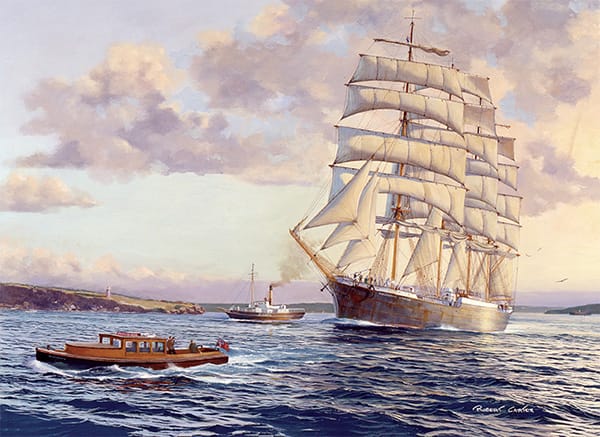Towards Falmouth "The four-masted barque Magdalene Vinnen" by Robert Carter
We continue our series on the marvellous paintings by Robert Carter OAM, FASMA, FISMP of the sailing ship era and published in The Marine Paintings of Robert Carter1.
Robert is one of Australia's leading marine artists and is also joint founder of the Australian Society of Marine Artists with Dean Claflin.2 You can read more about Bob's biographical information by clicking here.
In The Marine Paintings of Robert Carter Bob has presented his paintings in five parts and we are following this same format. We are up to Part Four: German Sail and French Ships where the ships painted by Robert illustrate that While Britain led the world in shipbuilding in the nineteenth century it was Germany, and to a lesser extent France, that took the sailing ship into the twentieth century.2
If you missed the last post in this series click here.
Today we showcase four-masted barque Magdalene Vinnen.

The year is 1933 and the German sailing ship Magdalene Vinnen clears Port Jackson (Sydney Harbour) sailing towards Falmouth for her orders.
She carries a full cargo of Australian wool. In the language of the sea, a sailing ship was always described as sailing ‘towards’ her next port rather than ‘to’. No doubt the term was coined to better describe the sailer’s track across the ocean, which, due to prevailing winds caused her to sail many miles away from her ‘rhumb’ line. This vessel was built as a cargo carrying training ship in 1921, for the Vinnen Company of Bremen. Otto Neumann her second mate told me that as she only carried fuel for 18 days she used her auxiliary engine for leaving or entering port or to get through the equatorial belt of calms known as the Doldrums.
In 1938 the Nord Deutscher Lloyd Line bought her and renamed her Kommodore Johnson. She sailed only within the Baltic during the War. In 1945 Russia claimed her as a war prize and renamed her Sedov. She continued in her new role as a pure training ship for the Department of Fisheries and ceased to carry cargo. Her ‘tween decks were converted to accommodation for the large contingent of cadets she would now carry and a row of portholes now pierces her sides. She is still afloat and to subsidise her running costs takes paying passengers. The pilot vessel in the background is the Captain Cook a familiar sight on Sydney Harbour and the small launch in the foreground is typical of a fleet of work-boats operated by Stannard Bros. Well known to those who frequented the waters of this great Port, they were used for a variety of tasks. In this case it is likely that a newspaper photographer has hired the boat – as a sailing ship leaving Sydney in 1933 was a rare sight indeed.3
© Thank you to Robert Carter who kindly gave permission for the image of his work to be shared on AnArt4Life.
Please check out the Robert Carter Website.
And also the site for the Marine Artisits Australia.
I will be back with more of Bob's wonderful paintings of what I consider to be the most beautiful of all human made structures.
Credits
1. The Marine Paintings of Robert Carter , Published in Australia by Robert Carter Maritime, Gosforth NSW, 2320, Australia, 2022
2. Correspondence with Robert Carter
3. robertcarter.com.au
